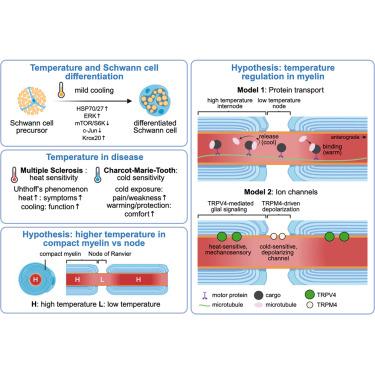New insights into the influence of temperature on axonal transport and function in myelinated regions of Schwann cells
IF 4.1
2区 综合性期刊
Q1 MULTIDISCIPLINARY SCIENCES
引用次数: 0
Abstract
Temperature within the range of 15°C–37°C plays a pivotal role in modulating cellular processes and is essential for understanding the complex mechanisms underlying axonal transport and function in myelinated regions of Schwann cells (SCs). This review presents a comprehensive overview of the current knowledge on the impact of temperature on various aspects of axonal function, including saltatory conduction, ion channel activity, molecular motor dynamics, and Schwann cell function. We also delve into the potential implications of these findings in the context of neurological disorders and their treatment. The temperature-dependent nature of saltatory conduction and action potential propagation in myelinated axons is of particular interest, as it directly affects the efficiency of nerve signal transmission. Additionally, the activity of ion channels in the nodes of Ranvier is subject to modulation by temperature, further emphasizing the importance of understanding temperature’s influence on neuronal function. This review concludes with a discussion of various unresolved questions in the field, and ideas are suggested for future research. Studying the precise molecular mechanisms underlying the temperature-dependent regulation of ion channels, molecular motors, and cytoskeletal components may lead to the development of novel strategies for the diagnosis and treatment of neurological disorders, which are commonly observed in demyelinating diseases and hereditary neuropathies. A deeper understanding of the role of temperature in neuronal function has the potential to significantly advance our knowledge of thermoregulation and neurologic function, ultimately leading to breakthroughs in the diagnosis and treatment of various neurological disorders.

温度对雪旺细胞髓鞘区轴突运输和功能影响的新见解
15°C - 37°C范围内的温度在调节细胞过程中起着关键作用,对于理解雪旺细胞(SCs)髓鞘区轴突运输和功能的复杂机制至关重要。本文综述了温度对轴突各方面功能的影响,包括跳跃传导、离子通道活性、分子运动动力学和雪旺细胞功能。我们还深入研究了这些发现在神经系统疾病及其治疗方面的潜在意义。有髓鞘轴突的跃变传导和动作电位传播的温度依赖性是特别有趣的,因为它直接影响神经信号传递的效率。此外,Ranvier节点中的离子通道活性受到温度的调节,进一步强调了了解温度对神经元功能影响的重要性。本文对该领域尚未解决的问题进行了讨论,并对未来的研究提出了建议。研究离子通道、分子马达和细胞骨架成分的温度依赖性调节的精确分子机制,可能会导致诊断和治疗神经系统疾病的新策略的发展,这些疾病通常见于脱髓鞘疾病和遗传性神经病。对温度在神经元功能中的作用的深入了解有可能显著推进我们对温度调节和神经功能的认识,最终导致各种神经系统疾病的诊断和治疗取得突破。
本文章由计算机程序翻译,如有差异,请以英文原文为准。
求助全文
约1分钟内获得全文
求助全文
来源期刊

iScience
Multidisciplinary-Multidisciplinary
CiteScore
7.20
自引率
1.70%
发文量
1972
审稿时长
6 weeks
期刊介绍:
Science has many big remaining questions. To address them, we will need to work collaboratively and across disciplines. The goal of iScience is to help fuel that type of interdisciplinary thinking. iScience is a new open-access journal from Cell Press that provides a platform for original research in the life, physical, and earth sciences. The primary criterion for publication in iScience is a significant contribution to a relevant field combined with robust results and underlying methodology. The advances appearing in iScience include both fundamental and applied investigations across this interdisciplinary range of topic areas. To support transparency in scientific investigation, we are happy to consider replication studies and papers that describe negative results.
We know you want your work to be published quickly and to be widely visible within your community and beyond. With the strong international reputation of Cell Press behind it, publication in iScience will help your work garner the attention and recognition it merits. Like all Cell Press journals, iScience prioritizes rapid publication. Our editorial team pays special attention to high-quality author service and to efficient, clear-cut decisions based on the information available within the manuscript. iScience taps into the expertise across Cell Press journals and selected partners to inform our editorial decisions and help publish your science in a timely and seamless way.
 求助内容:
求助内容: 应助结果提醒方式:
应助结果提醒方式:


